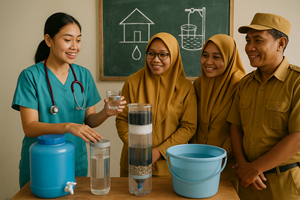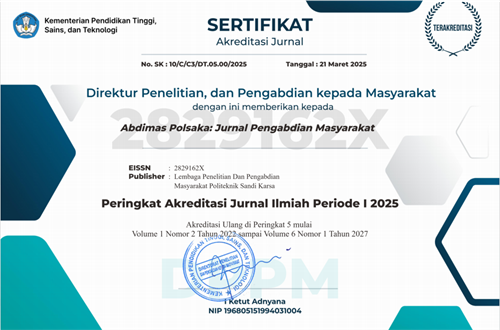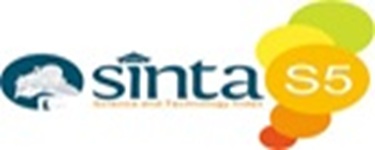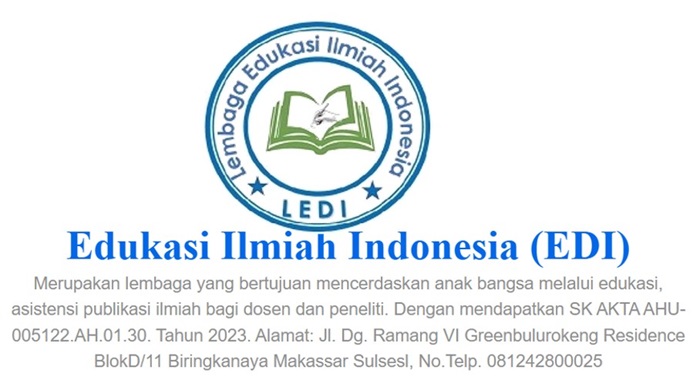Clean Water Self-Sufficiency and Well Water Filtration Method Education for Health Workers in Gowa Regency
DOI:
https://doi.org/10.35816/abdimaspolsaka.v4i2.115Keywords:
cadres, borehole water, clean water, filtrationAbstract
The quality of well water in Jenemadingi hamlet does not meet health standards. As a result, cases of diarrhea and stunting are also high. The purpose of this community service is to provide training in water purification techniques. This educational method is carried out in five stages, namely: the socialization stage and the implementation stage. This activity includes three sessions, namely: the first stage: pre-test, which is administered through a questionnaire, using lecture, question-and-answer, and discussion methods; post-test and evaluation of post-test results; technology implementation stage; monitoring and evaluation stage; and program sustainability stage. The results of the community service activity indicate that the socialization of clean water and sanitation education is beneficial for the community, as the community's knowledge has significantly improved. The average score increased from 20.22 in the pre-test to 23.18 in the post-test, with a p-value of 0.001, indicating a significant difference. These results confirm the effectiveness of the clean water sanitation education program.
Downloads
References
A. Baharuddin, M. khidri Alwi, S. A. Maharani, A. A. Aulia, and N. F. Mubakkira, “Pemantauan dan Edukasi Sanitasi Kualitas air Sumur Bor pada Masyarakat di Dusun Paramppunganta Desa Kampili Kab Gowa,” Wind. Community Dedication J., pp. 63–70, 2024, doi: https://dx.doi.org/10.33096/wocd.v5i2.2298.
A. Baharuddin and R. P. Poetra, “Cegah Stunting Dengan Edukasi Air Bersih Dan Jamban Melalui Pemberdayaan Masyarakat Berbasis Local Winsdom,” in Prosiding Seminar Nasional Pengabdian Kepada Masyarakat, 2023, vol. 4, pp. SNPPM2023ST-6.
S. Sudarningsih, T. Wianto, H. Madihah, L. Azizah, and N. Nabila, “Penentuan Kualitas Air Sumur Bor, Studi Kasus Daerah Pemukiman di Kecamatan Martapura Kota Kabupaten Banjar,” J. Pendidikan, Sains, Geol. dan Geofis. (GeoScienceEd Journal), vol. 5, no. 4, pp. 937–941, 2024.
E. Andayanie, Y. Yuliati, and A. Baharuddin, “Perilaku Masyarakat Terhadap Pemanfaatan Akses Layanan Air Bersih Di Dusun Jenemadingi Kab Gowa,” Wind. Community Dedication J., pp. 55–62, 2024, doi: https://dx.doi.org/10.33096/wocd.v5i2.2299.
R. N. Yenita, M. Ramadhani, and E. Saputri, “Pengaruh Air Bersih dan Status Ekonomi Terhadap Kejadian Stunting di Wilayah Kerja Puskesmas Tapung Hilir II,” J. homepage http//journal. pasca-unri. org/index. php/econews, vol. 4, no. 2, pp. 66–68, 2021.
A. Baharuddin, A. Junaid, and R. P. Poetra, “Edukasi Jamban Sebagai Upaya Pencegahan Stunting Berbasis Local Wisdom Pada Masyarakat Di Desa Tala-Tala,” Martabe J. Pengabdi. Kpd. Masy., vol. 6, no. 11, pp. 3880–3885, 2023, doi: https://dx.doi.org/10.31604/jpm.v6i11.3880-3885.
W. Angraini, M. Amin, B. A. Pratiwi, H. Febriawati, and R. Yanuarti, “Pengetahuan ibu, akses air bersih dan diare dengan stunting di puskesmas aturan Mumpo Bengkulu Tengah,” J. Kesmas (Kesehatan Masyarakat) Khatulistiwa, vol. 8, no. 2, p. 92, 2021, doi: https://dx.doi.org/10.29406/jkmk.v8i2.2816.
S. Handayani, S. Sudarti, and Y. Yushardi, “Analisis Kualitas Air Minum Berdasarkan Kadar Ph Air Mineral Dan Rebusan Sebagai Sumber Energi Terbarukan,” Opt. J. Pendidik. Fis., vol. 7, no. 2, pp. 385–395, 2023, doi: https://dx.doi.org/10.37478/optika.v7i2.3334.
N. E. Nemalamangwa, “Investigation of Water supply challenges in Thulamela Municipality: A case study of Bunzhe and Tshififi villages.” 2020.
D. M. Evans, A. L. Browne, and I. A. Gortemaker, “Environmental leapfrogging and everyday climate cultures: sustainable water consumption in the Global South,” Clim. Change, vol. 163, no. 1, pp. 83–97, 2020, doi: https://dx.doi.org/10.1007/s10584-018-2331-y.
S. Suprapto and D. Arda, “Pemberdayaan Masyarakat Melalui Penyuluhan Perilaku Hidup Bersih dan Sehat Meningkatkan Derajat Kesehatan Masyarakat,” J. Pengabdi. Kesehat. Komunitas, vol. 1, no. 2, pp. 77–87, Aug. 2021, doi: https://dx.doi.org/10.25311/jpkk.Vol1.Iss2.957.
R. L. Barnes, “A protein purification card game develops subject knowledge and transferable skills,” J. Biol. Educ., vol. 56, no. 4, pp. 365–375, 2022, doi: https://dx.doi.org/10.1080/00219266.2020.1799844.
S. Suprapto, D. Arda, M. Kurni Menga, B. Adji Saktiawan, S. Nggaá Woge, and A. Umar, “OPTIMALCARE: Community-based homecare policy innovation in accelerating stunting reduction in Makassar City,” Abdimas Polsaka, vol. 4, no. 2 SE-, pp. 148–156, Aug. 2025, doi: https://dx.doi.org/10.35816/abdimaspolsaka.v4i2.107.
E. B. Jeil, K. Abass, and J. K. Ganle, “‘We are free when water is available’: gendered livelihood implications of sporadic water supply in Northern Ghana,” Local Environ., vol. 25, no. 4, pp. 320–335, 2020, doi: https://dx.doi.org/10.1080/13549839.2020.1744118.
J. Grönwall and K. Danert, “Regarding groundwater and drinking water access through a human rights lens: Self-supply as a norm,” Water, vol. 12, no. 2, p. 419, 2020, doi: https://dx.doi.org/10.3390/w12020419.
Y. Yuliati, A. A. F. Azis, I. Dharlis, S. A. Fachrin, and A. Baharuddin, “Edukasi Air Bersih Sumur Bor Dan Pemanfaatan Sereh Menjadi Spray Lotion Anti Nyamuk DBD Pada Masyarakat Yang Memiiliki Akses Pelayanan Terbatas,” Martabe J. Pengabdi. Kpd. Masy., vol. 7, no. 9, pp. 3505–3510, 2024.
I. N. Auliah, K. Khambali, and E. Sari, “Efektivitas penurunan kadar besi (Fe) pada air sumur dengan filtrasi serbuk cangkang kerang variasi diameter serbuk,” J. Penelit. Kesehatan" SUARA FORIKES"(Journal Heal. Res. Forikes Voice"), vol. 10, no. 1, pp. 25–33, 2019.
M. Murraya, N. Taufiq-Spj, and E. Supriyantini, “Kandungan logam berat Besi (Fe) dalam air, sedimen dan kerang hijau (Perna viridis) di Perairan Trimulyo, Semarang,” J. Mar. Res., vol. 7, no. 2, pp. 133–140, 2018, doi: https://dx.doi.org/10.14710/jkt.v18i1.512.
Rasi Rahagia, Nour Sriyanah, Indrawati Aris Tyarini, Anita Lontaan, and Muh Yunus, “Upaya Pencegahan Stunting Berbasis Edukasi dan Sosialisasi,” Abdimas Polsaka, pp. 76–81, Mar. 2023, doi: https://dx.doi.org/10.35816/abdimaspolsaka.v2i1.38.

Additional Files
Published
How to Cite
Issue
Section
License
Copyright (c) 2025 Ella Andayanie, Alfina Baharuddin, Asmarani Harma, Annisa Junaid, Yuliati Yuliati, Suharni A. Fachrin

This work is licensed under a Creative Commons Attribution 4.0 International License.
Most read articles by the same author(s)
- Suharni A.Fachrin, Alfina Baharuddin, Fatma Jama, Hukma Ratu Purnama, Yuliati Yuliati, Ella Andayanie, Personal protective equipment as a measure to limit disability among ironworkers in maros regency , Abdimas Polsaka: Vol. 4 No. 2 (2025): Abdimas Polsaka: Jurnal Pengabdian Masyarakat
- Yuliati Yuliati, Alfina Baharuddin, Hardi Hardi, Siti Astachya Ananda Sofyan, Suharni A. Fachrin, Ella Andayanie, Optimizing clean water filtration through the application of science and technology: Reverse osmosis method , Abdimas Polsaka: Vol. 4 No. 2 (2025): Abdimas Polsaka: Jurnal Pengabdian Masyarakat




















